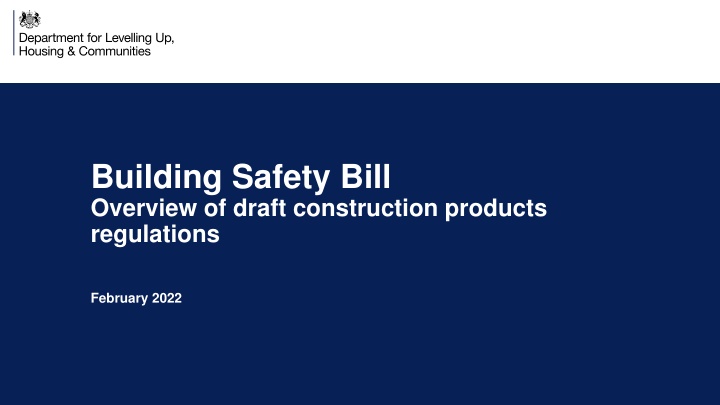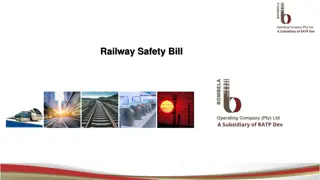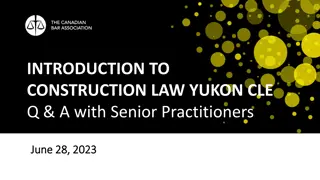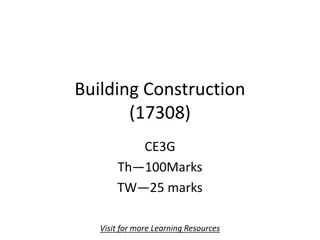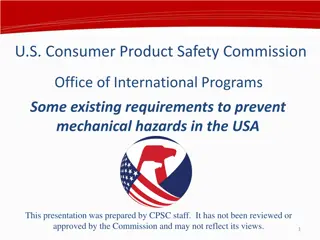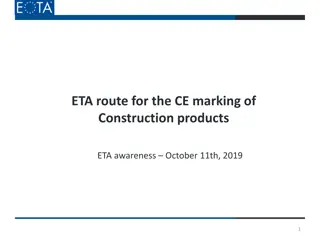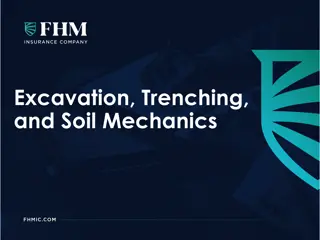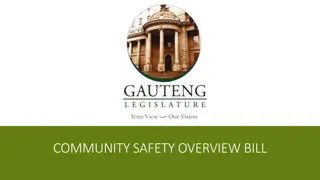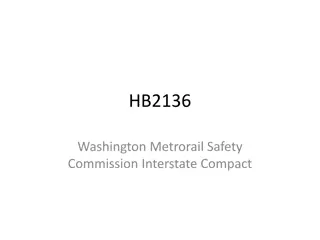Overview of Draft Construction Products Regulations in Building Safety Bill
The Building Safety Bill aims to address weaknesses in the regulatory regime regarding construction products by introducing regulations for their marketing and supply. The current framework faces issues such as limited enforcement, lack of technical expertise, and gaps in coverage, leading to potential risks in the market. The proposed regulatory framework seeks to enhance safety and oversight in the construction products sector.
Download Presentation

Please find below an Image/Link to download the presentation.
The content on the website is provided AS IS for your information and personal use only. It may not be sold, licensed, or shared on other websites without obtaining consent from the author.If you encounter any issues during the download, it is possible that the publisher has removed the file from their server.
You are allowed to download the files provided on this website for personal or commercial use, subject to the condition that they are used lawfully. All files are the property of their respective owners.
The content on the website is provided AS IS for your information and personal use only. It may not be sold, licensed, or shared on other websites without obtaining consent from the author.
E N D
Presentation Transcript
Building Safety Bill Overview of draft construction products regulations February 2022
Context Review of Building Regulations and Fire Safety ( Hackitt Review ) May 2018 Government accepted all recommendations. 15 recommendations covering product testing, test methods and standards, labelling and traceability, and enforcement and market surveillance. Grenfell Tower fire June 2017 Spread primarily through ACM cladding, killing 72 people. Polyisocyanurate (PIR) insulation contributed to speed and extent of spread. Smoke extractors did not operate as expected and fire doors did not perform to required standard. Building Safety Bill Introduced into Parliament in July 2021 Creates power to make regulations for the marketing and supply of construction products. This is intended to address weaknesses in current regulatory regime. Fire door investigation 2018 2019 Many construction products do not fall under a regulatory regime, meaning that regulators cannot enforce withdrawal or recall of products. New Future construction products regulations Grenfell Tower Inquiry Phase 1 report identified a number of matters of particular concern relating to construction products for further investigation in Phase 2 of the Inquiry: testing and certification of materials, design and choice of materials, fire doors and smoke extraction systems.
The existing regulatory framework: overview The existing regulatory framework for construction products in GB derives from the EU Construction Products Regulation 2011 (EU law continues to apply in Northern Ireland) Not all construction products are covered by the existing regulatory framework. Standards are mandatory for the 444 product families covered by a UK designated standard in Great Britain and a harmonised European standard in Northern Ireland. The UK Construction Product Regulations 2013 set out enforcement powers of the EU regulation, which is primarily for Trading Standards (although the Secretary of State has powers). For products subject to a designated standard in GB, or a harmonised standard in NI, manufacturers are required to: Put in place factory control processes Keep a register of complaints Provide a declaration of performance for at least one of the product s essential characteristics Withdraw and recall products that don t comply or present a risk Carry out an assessment and verification of constancy of performance (AVCP) which might include third party testing
Existing regulatory framework: issues Limited enforcement of existing regulatory regime Trading Standards lack technical knowledge and expertise in this area and do not prioritise construction products. Focus on harmonisation, rather than safety some products that would risk causing death or serious injury if they were to fail are not covered by existing regulations. No obligation on economic operators to ensure that products are safe or to provide information about any remaining risks. Regulatory gap not all construction products on the UK market covered by a regulatory framework. No national oversight of market surveillance and enforcement activity. There are a number of issues with the existing regulatory framework
Proposed regulatory framework: overview We want to ensure that all construction products available on the UK market fall under a regulatory regime. We will do this through: Creating a statutory list of safety critical products (where their failure would risk causing serious injury or death) and bringing the regulation of these products in line with those subject to a designated standard under the existing regime. Introducing a general safety requirement, requiring construction products to be safe before they can be placed on the UK market. Maintaining the existing regulatory approach for products subject to a designated standard (EU law will continue to apply in NI). This will be underpinned by a strengthened market surveillance and enforcement regime. We will create new powers that can be exercised by OPSS and local Trading Standards, so that safety concerns can be identified and dealt with and action can be taken against those who do not comply with the regulations.
Proposed regulatory framework: sequencing The Bill was introduced into Parliament in July 2021. It is not possible to say how long its passage through Parliament will take. Building Safety Bill passage through Parliament Bill receives Royal Assent and becomes law This will create legal powers to make our proposed regulations. Stakeholder engagement on draft regulations Formal consultation on draft regulations This will allow time for industry to prepare for new regulatory requirements. Amend draft and publish consultation response Regulations laid in Parliament We are engaging with a wide range of stakeholders, concurrent with the Bill s passage through Parliament, to inform the further development of draft regulations. Transition period Regulations come into force
General safety requirement: overview Safe product is a term that will be defined in the regulations as a construction product which, under normal or reasonably foreseeable conditions of use, taking into account certain matters: Does not present any risk to the health and safety of persons; or If it does, the risk is as low as it can be compatibly with using the product. We are proposing an approach modelled on existing requirements for consumer products (the General Product Safety Regulations 2005). We intend to introduce a requirement that manufacturers, importers and distributors must not place a construction product on the market unless it is a safe product. Manufacturers will be required to carry out a risk assessment that identifies all normal and reasonably foreseeable uses of the product, the risks associated with these and the ways in which risks can be eliminated or reduced. Importers and distributors will be required to ensure that the manufacturer has fulfilled their obligations under the general safety requirement. Other obligations on these groups will broadly mirror those on manufacturers in a way that is relevant to their function. The regulations will also introduce specific requirements on manufacturers, importers and distributors in relation to the following: The provision of technical documentation and customer information Labelling the product with their details Sample testing Correcting, withdrawing or recalling unsafe products.
Safety Critical Products We intend to create a statutory list of safety critical products. BSI will be commissioned to revise or develop appropriate product standards. These are defined as construction products where their failure would risk causing death or serious injury to any person. Industry leaders recommend an appropriate implementation period to enable compliance with new standard. Industry leaders will propose products to be added to the safety critical list. Manufacturers will be required to declare the performance of safety critical products to a specific standard and put in place measures to ensure that this is consistently met, bringing their regulation in line with arrangements for products covered by the existing regulations. We intend that the process for adding products to the safety critical list will operate along the following lines Secretary of State adds product to the safety critical list and sets implementation period (during which manufacturers can use new standards on a voluntary basis). Industry leaders review the products on the safety critical list on a regular basis, adding and removing products as appropriate. Obligations on importers and distributors will broadly mirror those on manufacturers in a way that is relevant to their role. Following the implementation period, manufacturers and other economic operators must comply with the new requirements. We are keen to hear the views of industry representatives and others as to how the process for adding products to the safety critical list should be operated.
False or misleading claims about performance An economic operator must not make a claim, representation or commercial communication about a construction product that they make available on the market if they know, or are reckless as to whether, it is false or misleading about the product s performance on a construction works with respect to any of the basic requirements for construction works. This is not creating a new burden on economic operators the Business Protection from Misleading Marketing Regulations 2008 (BPMMR) already prohibits all misleading advertising. Including this provision will create the power to enable OPSS to start enforcing against false and misleading claims about the performance of construction products (Trading Standards already have powers to enforce the BPMMR). A claim, representation or commercial communication which omits anything relevant to the products effect on a construction works with respect to any of the basic requirements of construction works is to be treated as misleading. We will need to ensure that we create a market surveillance and enforcement regime that enables regulators to identify false and misleading claims about performance so that they can take action against this.
Market surveillance and enforcement powers The regulations will create a number of market surveillance and enforcement powers than can be exercised by local Trading Standards, the Secretary of State or a person appointed by the Secretary of State. This will pave the way for the National Regulator for Construction Products, which will be based in the Office for Product Safety and Standards (OPSS). Examples of the powers that will be created include the following: Sanctions Notices and forfeiture Rectifying a specific product compliance notice Preventing further harm Withdrawal Notice, Recall Notice, Notice to Mark, Notice to Warn, Forfeiture Application. Rectifying a systemic problem Improvement Notice. Financial penalties an administrative decision by regulator, at civil standards. Criminal offences Courts may impose custodial sentences or unlimited fines. Monitoring and investigation Require provision of information, identification of other economic operators and the production of documents. Enter premises (with and without warrant) and require assistance from persons on premises. Purchase goods. Observe the carrying on of business. Seize and detain goods and documents. The regulations will also: Set out the threshold at which enforcement authorities can use these powers. The process for appeals against notices. The activities undertaken by enforcement authorities for which they may recover costs from economic operators. Enable the sharing of information between enforcement authorities and relevant persons for relevant functions (e.g. other regulators). Undertakings Voluntary arrangements proposed by business which become binding. Failure to comply allows enforcement action to commence.
Why is this relevant to IRPM members? Strengthening of Regulatory Regime Supporting those who buy and use construction products Greater Market Surveillance and Enforcement Powers Why IRPM members may have an interest in our draft regulations: The regime for market surveillance and enforcement will be strengthened, to monitor compliance and ensure that action can be taken against those who break the rules. This should provide confidence to IRPM members that regulators can act where a product is unsafe. Through strengthening the regulatory framework for construction products, IRPM members should have more confidence that the products used in the buildings that they manage will be safe and perform as intended. The requirements around the provision of information will help to support those who buy and use products to make good, informed choices about the products that they use to meet the requirements of building regulations. As well as any general views, we are also keen to understand whether this regulatory framework will address any issues that you have experienced through building work that has been undertaken on the buildings that you manage.
